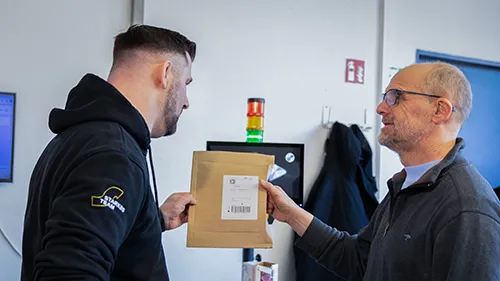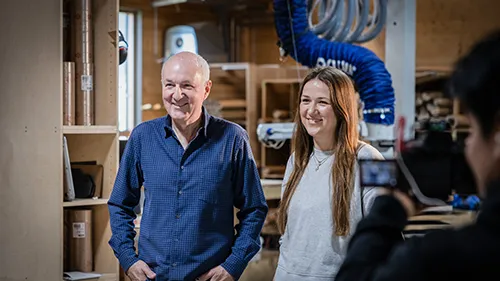SPRICK INSIGHTS: LogisticCity in Nürnberg
Video-Interview
The LogisticCity in Nuremberg is the logistics center of the Hoffmann Group, which was put into operation at the end of 2021. As a market-leading partner for quality tools, the company provides products to more than 135,000 customers worldwide.
The increased output of the highly automated LogisticCity was the driving force behind a fundamental reorientation in the field of cushioning materials. To meet the new requirements of the packaging process, Papier Sprick supplied a demand-oriented and efficient solution with the PaperJet® paper cushioning system.
120,000 different catalog items, 80 packing stations and up to 40,000 packages per day – the LogisticCity presents complex demands for a packaging solution. Before the LogisticCity was built, the Hoffmann Group used foil cushions as padding material.
Several impulses moved the decision in the direction of recycled paper: The innovative concept of LogisticCity should be continued in the field of sustainability. “The desire for a more eco-friendly packaging material was also expressed by customers,” says junior project and process Manager Jonas Karg. In addition, regulatory requirements for the import of plastic foil to other countries influenced the decision-making process.
Paper and foil-based solutions from various manufacturers were put to the test in practice and evaluated by employees on the basis of feedback sheets, among other criteria. Papier Sprick entered the race with the PaperJet®, an extremely fast system for producing paper cushions.
Several impulses moved the decision in the direction of recycled paper: The innovative concept of LogisticCity should be continued in the field of sustainability. “The desire for a more eco-friendly packaging material was also expressed by customers,” says junior project and process Manager Jonas Karg. In addition, regulatory requirements for the import of plastic foil to other countries influenced the decision-making process.
Paper and foil-based solutions from various manufacturers were put to the test in practice and evaluated by employees on the basis of feedback sheets, among other criteria. Papier Sprick entered the race with the PaperJet®, an extremely fast system for producing paper cushions.
The test clearly showed the advantages of the PaperJet® over the foil solution and other paper-based materials. “Initial skepticism about the paper solution was quickly resolved. The employees favored the PaperJet® and preferred to work at these workstations,” says Michael Scholz, Team Leader Logistics Small Packaging.
THE PAPERJET® SUCCEEDED IN TESTING
Jörg Kaschny, Papier Sprick’s sales manager, was there from the start of the test phase to support and advise. “This reliable service was very valuable for us,” says Karg. “With Mr. Kaschny, we have a central contact who takes care of all matters.” The test setups were accompanied by packing training sessions. Here, Kaschny informed the employees about cushioning and packaging options, carton sizes and the workflow.
SHORT SET-UP TIME, VERSATILE CUSHIONING
By integrating the PaperJet®, the workflow was optimized as a whole. Today, a total of 80 machines are placed in both the small and large packaging departments. In the small packaging department, the PaperJet® produces cushions in a dispenser at the packing table, while in the large packaging department, the employees remove the cushions directly from the machine. The central pre-production of foil pads and subsequent distribution to the packing stations has thus been replaced. “Packing is now much more flexible than before,” says Scholz. The freely selectable cushion lengths make it possible to fill voids with a precise fit.
Jörg Kaschny, Papier Sprick’s sales manager, was there from the start of the test phase to support and advise. “This reliable service was very valuable for us,” says Karg. “With Mr. Kaschny, we have a central contact who takes care of all matters.” The test setups were accompanied by packing training sessions. Here, Kaschny informed the employees about cushioning and packaging options, carton sizes and the workflow.
SHORT SET-UP TIME, VERSATILE CUSHIONING
By integrating the PaperJet®, the workflow was optimized as a whole. Today, a total of 80 machines are placed in both the small and large packaging departments. In the small packaging department, the PaperJet® produces cushions in a dispenser at the packing table, while in the large packaging department, the employees remove the cushions directly from the machine. The central pre-production of foil pads and subsequent distribution to the packing stations has thus been replaced. “Packing is now much more flexible than before,” says Scholz. The freely selectable cushion lengths make it possible to fill voids with a precise fit.
“The short set-up time is a crucial point which makes the PaperJet® so attractive. We now switch the material pallet every 3 to 4 weeks per workstation. This means a considerable time saving compared to the previous 1 to 2 roll changes of foil material per day,” says Karg. This is made possible by the ComPackt® endless pallet in a space-saving fanfold which offers 7,600 meters of recycled paper on a small footprint.
THE PACKAGING SOLUTION AS CIRCULAR ECONOMY
The Hoffmann Group pursues the idea of sustainability not only in its choice of cushioning material. “We generate 600 tons of paper waste annually, the majority from incoming goods,” explains Karg. Previously, the waste was collected in several presses, which were then picked up separately for disposal. Now the waste paper is pressed in the company’s own baling press. Papier Sprick can use the bales produced in this way to manufacture more paper for the PaperJets® used in the LogisticCity in the course of regular material deliveries at its own paper mill in Diemelstadt. These bales can be used by Papier Sprick to produce more paper for the PaperJets® used in the LogisticCity. This is done at the Papier Sprick paper mill in Diemelstadt and provided through the regular material deliveries.
The Hoffmann Group pursues the idea of sustainability not only in its choice of cushioning material. “We generate 600 tons of paper waste annually, the majority from incoming goods,” explains Karg. Previously, the waste was collected in several presses, which were then picked up separately for disposal. Now the waste paper is pressed in the company’s own baling press. Papier Sprick can use the bales produced in this way to manufacture more paper for the PaperJets® used in the LogisticCity in the course of regular material deliveries at its own paper mill in Diemelstadt. These bales can be used by Papier Sprick to produce more paper for the PaperJets® used in the LogisticCity. This is done at the Papier Sprick paper mill in Diemelstadt and provided through the regular material deliveries.
We pack your product
Send your product to the following address and we will send it back to you safely with our packaging solution:
Sprick GmbH & Co.
Packaging sample
Hanfstraße 23
33607 Bielefeld
Germany
Please remember to enclose a return address and a contact person or optionally fill out this PDF and enclose it with the parcel.
Non-binding live presentation
Learn about the features of our systems in a personalised online presentation and ask any questions you may have. Simply request an appointment and we will get back to you!
What you can take away for yourself
How can I protect my products for shipping?
Choosing a suitable packaging solution is crucial to avoid damage when shipping products. Paper cushions are ideal for heavy or fragile goods as they secure the products in the package and offer additional protection. Our paper cushions made from 100% recycled paper from our own production enable you to create a sustainable packaging process.
Which packaging solution is suitable for high shipping volumes?
Shippers with high shipping volumes, for example in the fulfilment, e-commerce or logistics sectors, are faced with the challenge of coping with a high daily shipping output. As the fastest paper cushioning system on the market, the PaperJet® offers an efficient solution. The system enables particularly fast, product-compatible packaging and an optimised process flow.
How can I make my packaging process more sustainable?
A paper packaging solution is one way of making the packaging process more eco-friendly. Our paper packaging is made from 100% recycled paper with no virgin fibre added and can simply be disposed of with the waste paper. This not only supports the conservation of resources and the circular economy, but also enables a positive unpacking experience for the recipient.
How do I find a suitable packaging solution for my Packstation?
Determining an efficient packaging solution requires careful consideration of the products, the packing area and the workflow. With over 140 years of experience in the packaging industry, we are your reliable partner for transport protection. Our team will analyse your needs and determine an individual, product-specific solution. From conception to integration and beyond, we are at your side with reliable support. This is how we accompany you on the way to the optimum packaging solution.



